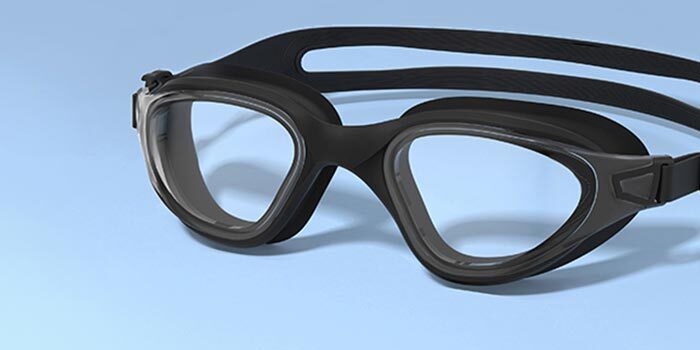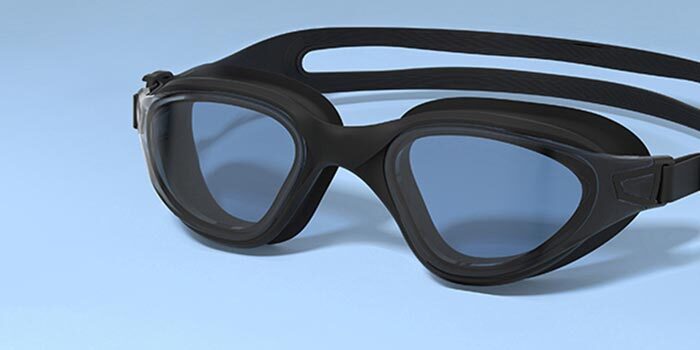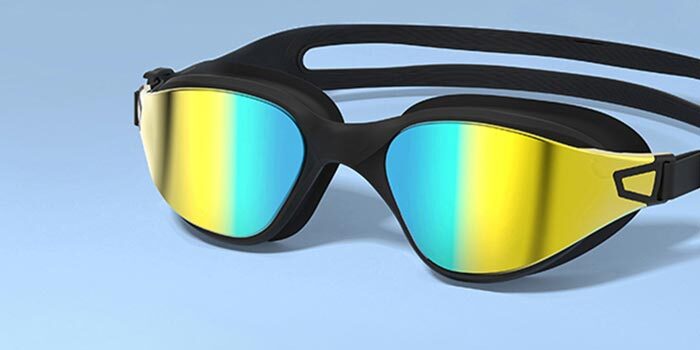Is a Swim Mask Better than Goggles? Which is Better for You?
27th Apr 2025
Masks Vs Goggles?
Swimmers often have to make a personal choice between swim masks and goggles. Both options have unique advantages and disadvantages, making it a personal and significant decision to determine which is better for their needs, based on their preference and the specific swimming environment.
This POD Ware article breaks down their differences, helping you make an informed choice for your following watersports adventure.
Key Differences Between Swim Masks and Goggles
Understanding the practical differences between swim masks and goggles can significantly enhance your swimming experience. Let's delve into their design, functionality, and purpose so you can feel fully prepared for your next swimming adventure.
Design and Fit
Swim masks and goggles are designed for different watersport purposes. With their more extensive coverage, including the eyes, nose, and sometimes the mouth, swim masks provide a snug fit that assures comfort and security while keeping water out.
Goggles, on the other hand, are smaller and simply cover the eyes and surrounding area. They rely on a tighter seal around the eye sockets and often feature adjustable headband straps for a secure fit.
Swim masks often have a flexible skirt, or what we like to refer to as a facial gasket, that conforms to the shape of the face. This emphasis on personal fit and comfort is a testament to the consideration that goes into their design.
Field of Vision
Regarding visibility, swim masks generally offer a wider field of view. Their larger lenses provide an expansive view of your surroundings, which can be particularly beneficial in open water. Goggles typically have smaller lenses, giving you a more focused view but sacrificing some peripheral vision.
A swim mask might be the better choice if you enjoy exploring underwater or want to enjoy the scenery during an open-water swim.
Comfort and Seal
Comfort is a crucial factor in any swim gear. With their larger surface area, swim masks are designed for extended comfort during longer sessions. Their design also creates a more substantial barrier against water intrusion, enhancing the seal and comfort they provide.
Goggles can sometimes fit too snugly around the eyes, leading to discomfort during extended wear. It is critical to find a good size fitting; if they are too small, they will increase pressure and pain around the eyes. However, many swimmers prefer goggles for their lighter feel. The correct option often depends on personal preference and sensitivity to pressure.
Can swim goggles cause headaches?
Yes, swimming goggles can cause headaches, and there are a few reasons why this might happen:
- Tight Fit: If the goggles are too tight, they can put pressure around the eyes and forehead, leading to discomfort or headaches.
- Nasal Bridge Pressure: Some goggles may press too firmly on the bridge of the nose, which can also lead to pain or headaches.
- Inadequate Padding: Goggles without sufficient padding may create pressure points, leading to discomfort during and after swimming.
- Prolonged Use: Spending extended periods in the water while wearing ill-fitting goggles can cause discomfort and strain, potentially resulting in headaches.
If you regularly experience headaches while using goggles, try adjusting the fit, changing models, or taking breaks during your swim. If the problem persists, it might be worth consulting with a medical professional.
Can you surf with goggles?
Wearing goggles is not just a safety measure; it's a game-changer for your surfing experience. They help you see beneath and above the water more clearly, reduce glare, and protect your eyes from UV exposure. Quality UV-rated lenses can reduce the risk of developing cataracts and slow the progression many surfers contend with.
They're also great for bodyboarding and bodysurfing, where you're closer to the water and more prone to water splashback.
Variety in Lenses
Goggles come in various styles, tints, and sizes. Whether you need tinted lenses to block out glare, clear lenses for low-light conditions, or mirror lenses to totally reflect and block out more sunlight, there's a pair out there.
- Clear Lenses: These are popular for indoor swimming or low-light conditions because they let in the most light. They provide the best visibility when swimming under artificial lighting or cloudy weather.

- Tinted Lenses: These are commonly used for outdoor swimming, especially in bright, sunny conditions. They help reduce glare from the sun and provide better contrast. They're great for open-water swimming or outdoor pools.

- Mirrored Lenses: These are similar to tinted lenses but with an additional reflective coating. They're especially popular for outdoor swimming in bright conditions as they block out more sunlight and reduce glare. Athletes often prefer mirrored lenses for races, triathlons, or outdoor training.

This variety makes it easy for swimmers to find goggles that suit their unique preferences and needs.
In terms of popularity, clear lenses are often the go-to for indoor swimming. In contrast, tinted and mirrored lenses are more popular for outdoor swimming due to the added benefit of glare reduction. So, it depends on where and when you're swimming, but tinted lenses tend to be favoured for versatility across various conditions!
Why are swimming goggles lenses blue or black?
Swimming goggles often have blue or black tinted lenses for several reasons:
- Light Reduction: Blue or black tinted lenses can help reduce glare from the water's surface and bright sunlight, providing more eye comfort during outdoor swims.
- Enhanced Contrast: Tinted lenses will improve contrast, making it easier to see underwater and help you gauge your surroundings, particularly in brighter conditions.
- Aesthetic Appeal: Many brands offer a variety of colours for style and personal preference. Blue is a popular choice because it's visually appealing.
- UV Protection: Some tinted lenses provide additional UV protection, which is vital for outdoor swimming. This helps protect your eyes from the sun's harmful ultraviolet rays.
Clear to lightly tinted lenses are suitable for swimming indoors or in low-light conditions. They allow for better visibility without altering the colours around you.
Should I look at mirror lenses, considering I am an open-water swimmer?
Yes, mirror lenses can be excellent for open-water swimming and outdoor water sports!
Here are some benefits of using mirror lenses:
- Glare Reduction: Mirror lenses help reduce glare from the sun reflecting off the water, making it easier to see and navigate during swimming and other activities, such as jet skis and skiing.
- Increased Comfort: By minimising brightness, mirror lenses can enhance comfort during long swims, helping to prevent eye strain.
- UV Protection:Some tinted lenses provide additional UV protection, which is vital for outdoor swimming. This helps protect your eyes from harmful ultraviolet rays.
- Enhanced Visibility: The reflective surface can help improve your visibility to others, which can be a safety advantage in open water conditions.
- Style: Mirror lenses often have a stylish look, which can be an added bonus!
Popular Mirrored Lenses
- Blue mirrored lenses are popular for their stylish aquatic appearance and incredible, neutral viewing experience with natural colour enhancement and glare reduction. They also provide a soothing effect on the eyes, making them a functional choice. These are particularly beneficial if you enjoy outdoor swimming, sailing, or cycling, and a triathlon is necessary.
- Gold lenses are reflective lenses that provide a warm, subtle golden hue and enhance vision clarity. They also have a soothing tint that improves contrast and depth judgment. They offer excellent glare reduction and are particularly effective in direct bright and reflective sunlight.
- Silver mirrored lenses typically provide accurate colour perception and natural contrast. They're suitable for various outdoor activities, making them a classic and versatile choice for all water sports.
When choosing goggles for outdoor watersports like open-water swimming and triathlons, consider your typical swimming conditions (time of day, weather, water clarity) to ensure you select the right lens type for your needs.
Try on different styles to find the pair that fits comfortably and securely. A good fit is crucial for performance and comfort in open water.
How do I keep swim goggles from fogging, or should I buy anti-fog lenses?
To keep your swim goggles from fogging up, here are a few tips:
- Anti-Fog Spray or Gel: Anti-fog solutions are designed to prevent fogging. Apply the solution on the inside of your goggles before swimming will help.
- Spit and Rinse: A simple (but effective) trick is to spit on the inside of your goggles, avoid touching them with your finger, and rinse lightly with water. The natural enzymes help prevent fogging.
- Rinse with Cold Water: Rinsing your goggles with cold water before putting them on can help minimise fogging, as the temperature difference between your face and the water won't cause as much condensation inside.
- Dry Them Properly: After swimming, let your goggles dry properly and store them in a case. Moisture inside can lead to fogging.
- Avoid Touching the Lenses: Oil and dirt on your fingers can contribute to fogging, so avoid touching the inside of the lenses or rubbing with your fingers after use in saltwater; the salt residue can scratch the lens surface.
- Anti-fog Lenses are a great option, especially if you swim regularly. They often last longer than sprays or gels and provide more consistent performance. However, direct contact can wear off the inner surface anti-fog coating over time.
Do you swim a lot or just occasionally? That might help you decide whether to get anti-fog lenses or just use a spray.
Advantages of Swim Masks
Choosing a swim mask has its own set of benefits. Here's what makes them appealing.
Increased Comfort for Longer Sessions
For those who swim longer, swim masks can enhance comfort. The larger fit means less pressure builds around the eyes, making losing track of time in the water easier. Consider a swim mask if you're training for a long-distance swim or enjoy extended sessions.
Better for Open Water Swimming
If your adventures take you beyond the pool, swimming masks shine in open water settings. They provide a greater field of vision, which is crucial when swimming in unpredictable waters. The added buoyancy of a mask can also give a sense of security, allowing you to focus more on your surroundings rather than the gear.
Swim masks have either a two-piece or one-piece lens; we have not added an adult model to the POD Ware swim range due to the complexities of fit and comfort with a functional, streamlined facial lens wrap and gasket to accommodate most adult facial structures.
Advantages of Goggles
Conversely, goggles have perks that appeal to a wide range of swimmers.
Streamline Design for Speed
Goggles are designed with performance in mind. Their compact structure reduces drag, allowing you to cut through the water more efficiently. Modern lens designs have greater curvature and have a broader vision. If speed and agility are your goals, goggles are a better fit. Competitive swimmers often choose goggles for this very reason.
Consider Your Swimming Environment
Think about where you'll be swimming. Goggles work well for pool swims. They fit snugly and offer good visibility. However, if you're venturing into lakes or oceans, a swim mask's broader field of vision might be more suitable, enhancing both safety and enjoyment.
Assessing Comfort and Fit Preferences
Everyone's face is different, and comfort levels vary. Don't shy away from trying both options. Experimenting with various fits and styles can lead you to the perfect choice. Pay attention to how they feel as you wear them. A goggle that's too tight could ruin your swim, while one that's too loose might let in water.
AquaLuxe Swim Goggles by POD®
These modern goggles have clear, black-tinted, blue, or gold mirror lenses framed in soft silicone, flexible black or white surround, nose bridge and gaskets. They also have side-adjustable classic split-back headbands.
AquaLuxe biofit facial design and headband adjust perfectly to most face shapes, offering a custom fit based on most facial structures. The ever-clear 180-degree broad field of vision, anti-fog, UV protection, and curved lenses stay clear for vivid, high-contrast lenses that enhance visibility.
Due to their majority fitting size, the AquaLuxe goggles are not limited to a single water sports style. They are versatile and ideal for swimming training, pool or open-water swimming, triathlons, body surfing, and a day at your local wave pool. With these goggles, you can take on any water sports challenge.
Our Conclusion for Intrigued Water Sports Enthusiast
Consider your swimming habits and comfort when deciding between a swim mask and goggles.
Swim masks offer greater visibility and comfort for longer swims, while goggles in various styles enhance swimming performance by catering to a wide range of aquatic activities.
Ultimately, the choice is personal. Weigh the pros and cons discussed here, and choose the gear that makes your swim more enjoyable. With the right equipment, every dip into the water can be a refreshing experience.
Happy swimming for the POD aquatic team.
